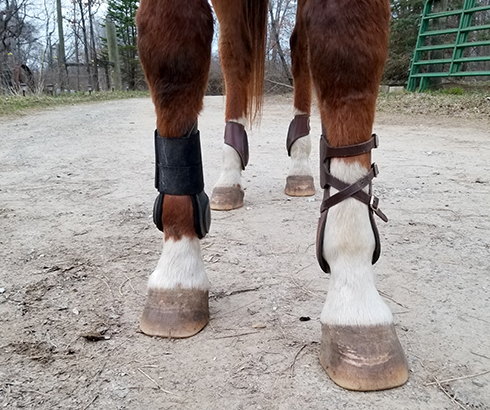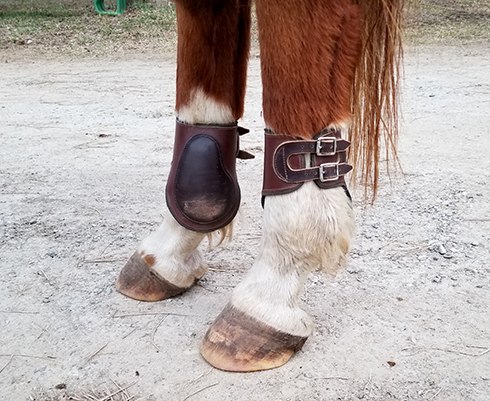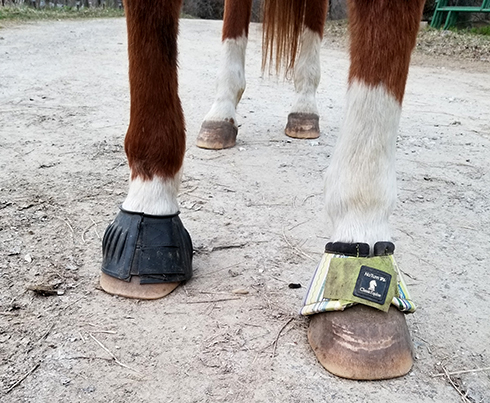How to protect your horse’s legs
Explore several options to help protect your horse’s leg during exercise.

Most equestrians have one thing in common: the constant concern of their horse’s health and safety. One of the most common types of injuries for horses are leg injuries. Many such injuries can be prevented by using proper leg protection during exercise.
Polo wraps
The first type of leg protection we’ll discuss is the polo wrap. These are typically made from fleece and have a slight stretch to them. Polo wraps are the only leg protection that will simultaneously provide tendon support and leg protection, making them popular with young horses that do not yet have full control of their bodies.
Polo wraps must be properly applied to the horse or you may increase the risk of a bowed tendon occurring during exercise. Watch this video on how to wrap a horse’s leg from Michigan State University Extension for a detailed description on how to apply a polo wrap. Ensure your wraps only place pressure on the front of the cannon bone and only light pressure on the delicate tendons behind the leg.
Splint boots

Our next form of leg protection is the splint boot. In Photo 2, it is the green boot on the horse’s right leg. The splint boot, aptly named for the intended protection of the splint bone, is one of the simplest forms of leg protection. These boots have just three Velcro strips for application.
Simply place the boot against the horse’s leg, slide it down a bit to smooth the hair underneath, and fasten the Velcro through the metal loops. You want them snug, but not so tight that they cause discomfort or limit blood flow. Make sure the Velcro tails are pointing towards the tail of the horse. Again, so all pressure is on the cannon bone, not the tendons.
Sports medicine boots
The right boot on the horse’s left leg in Photo 2 is a sports medicine boot. These boots provide an all-around, heavy-duty protection for the leg. These are made of thick neoprene and a Velcro layer covering. These are intended for strenuous, hard work such as speed events or endurance. These boots are also very simple in application.
Simply place the boot on the leg so it cups the fetlock, and bring your top three Velcro around to secure, again, ensuring the tails face towards the tail of the horse. The bottom Velcro will come up and across the fetlock, providing support and protection to the fetlocks during work.
Open front boots

Open front boots are more common with horses that are used for activities over fences. The ones with Velcro are typically used for practice at home and the leather ones with buckles are more often used during competition.
Each type of open front serves the same purpose: to protect the leg and tendons from the back feet clipping them, while still leaving the bulk of a boot off the front to avoid accidentally knocking a rail.
Fetlock boots

Fetlock boots are used on hind legs to prevent the fetlocks from catching each other, most commonly in horses used over fences. You can clearly see by the scuff marks in Photo 4 that these boots have served their purpose on a horse already.
These boots match the buckle open fronts discussed earlier to make a complete set. These boots can also be found in a Velcro set, fastening similarly to the splint boots.
Bell boots

Our final kind of leg protection we’ll discuss here is the bell boot. There are two different kinds of bell boots shown in Photo 5, both serving a similar purpose of protecting the heel bulb of the front leg from being struck by an overreaching hind foot. The striped, green boot in the picture is made of a comfortable, soft material that is strong enough to protect but gentle enough to not rub the ankles of the horse. If a horse is moving at a strong gait, there is always a chance a back foot may catch a heel bulb or shoe and potentially cause damage. By protecting the area during work, we are hoping to prevent injury or costly vet or farrier bills.
The black boot in the picture is more often used for daily turnout and is made of rubber. These can also be used for work, but aren’t as strong at high-speed impact. Bell boots should always come in contact with the ground. The entire heel bulb and shoe should be covered by the boot for proper protection.
While we can never completely eliminate all risks, we can work to prevent or lessen the risk of injury, keeping both our horses and pocketbooks healthier.



 Print
Print Email
Email

